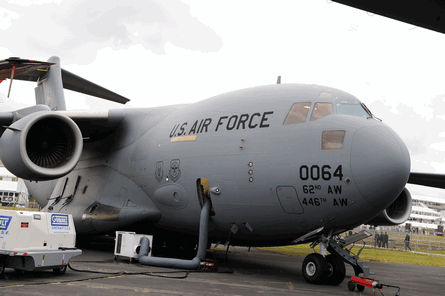Boeing hopes to exploit a gap between the fielding of the US Army’s future combat systems brigades from 2015 and the introduction of a yet-to-fly joint future theater lift (JFTL) aircraft from 2025.
The basic C-17A is already in widespread use in the theatre transport role and Boeing insists that a developed, dedicated C-17 variant would offer 80% of the capability of a new design, at about 10-20% of the development cost – and could be ready on time in 2015.
The new C-17B features upgraded 13% higher thrust P&W engines with a new FADEC and fan, and a redesigned trailing edge flap to allow better short field performance. It will have a new, extra main landing gear on the centreline, with a tyre deflation/inflation system to allow operations from softer surfaces.
|
|---|
The current aircraft requires a California Bearing Ratio of 12, while the C-17B will be able to operate from surfaces with a California Bearing Ratio of six – equivalent to a ploughed farmer’s field. The aircraft will be fitted with an all-weather, autonomous landing system and a coupled opportune landing site (OLS) system. The latter will allow a potential landing site to be accurately assessed from the air, ensuring that it is free of obstacles and is smooth and firm enough.
This OLS has already been flown aboard a surrogate platform in conjunction with the University of Bowling Green, Ohio.
All of this means that the C-17B will be able to operate from a 2,000ft strip while carrying two FCS vehicles – where JFTL will carry only one. In fact, the C-17B will equal or better the planned new aircraft in meeting most of the requirements specified for the next generation JFTL.
The C-17B is utterly dependent on keeping the existing C-17A production line open, and only if this occurs will there be “opportunities to bridge to the affordable tactical C-17B” according to Boeing’s former vice president of global systems, Dave Bowman.
Source: Flight International

















